Westminster Abbey, formally titled the Collegiate Church of Saint Peter at Westminster, is an Anglican church in the City of Westminster, London, England. Since 1066, it has been the location of the coronations of 40 English and British monarchs and a burial site for 18 English, Scottish, and British monarchs. At least 16 royal weddings have taken place at the abbey since 1100.
Although the origins of the church are obscure, an abbey housing Benedictine monks was on the site by the mid-10th century. The church got its first large building from the 1040s, commissioned by King Edward the Confessor, who is buried inside. Construction of the present church began in 1245 on the orders of Henry III. The monastery was dissolved in 1559, and the church was made a royal peculiar – a Church of England church, accountable directly to the sovereign – by Eliza...Read more
Westminster Abbey, formally titled the Collegiate Church of Saint Peter at Westminster, is an Anglican church in the City of Westminster, London, England. Since 1066, it has been the location of the coronations of 40 English and British monarchs and a burial site for 18 English, Scottish, and British monarchs. At least 16 royal weddings have taken place at the abbey since 1100.
Although the origins of the church are obscure, an abbey housing Benedictine monks was on the site by the mid-10th century. The church got its first large building from the 1040s, commissioned by King Edward the Confessor, who is buried inside. Construction of the present church began in 1245 on the orders of Henry III. The monastery was dissolved in 1559, and the church was made a royal peculiar – a Church of England church, accountable directly to the sovereign – by Elizabeth I. The abbey, the Palace of Westminster and St. Margaret's Church became a UNESCO World Heritage site in 1987 because of their historic and symbolic significance.
The church's Gothic architecture is chiefly inspired by 13th-century French and English styles, although some sections of the church have earlier Romanesque styles or later Baroque and modern styles. The Henry VII Chapel, at the east end of the church, is a typical example of Perpendicular Gothic architecture; antiquarian John Leland called it orbis miraculum ("the wonder of the world").
The abbey is the burial site of more than 3,300 people, many prominent in British history: monarchs, prime ministers, poets laureate, actors, scientists, military leaders, and the Unknown Warrior. Due to the fame of the figures buried there, artist William Morris described the abbey in 1900 as a "National Valhalla".
Historians agree that there was a monastery dedicated to Saint Peter on the site prior to the 11th century, though its exact origin is somewhat obscure. One legend claims that it was founded by the Saxon king Sæberht of Essex, and another claims that its founder was the fictional 2nd-century British king Lucius.[1] One tradition claims that a young fisherman on the River Thames had a vision of Saint Peter near the site. This seems to have been quoted as the origin of the salmon that Thames fishermen offered to the abbey, a custom still observed annually by the Fishmongers' Company.[2]
The origins of the abbey are generally thought to date to about 959, when Saint Dunstan and King Edgar installed a community of Benedictine monks on the site.[3] At that time, the location was an island in the middle of the River Thames called Thorn Ey.[4] This building has not survived, but archaeologists have found some pottery and foundations from this period on the abbey site.[5]
Edward the Confessor's abbeyBetween 1042 and 1052, Edward the Confessor began rebuilding Saint Peter's Abbey to provide himself with a royal burial church. It was built in the Romanesque style and was the first church in England built on a cruciform floorplan.[6] The master stonemason for the project was Leofsi Duddason,[7] with Godwin and Wendelburh Gretsyd (meaning "fat purse") as patrons, and Teinfrith as "churchwright", probably meaning someone who worked on the carpentry and roofing.[8] Endowments from Edward supported a community that increased from a dozen monks during Dunstan's time, to as many as 80.[9] The building was completed around 1060 and was consecrated on 28 December 1065, about a week before Edward's death on 5 January 1066.[10] A week later, he was buried in the church; nine years later, his wife Edith was buried alongside him.[11] His successor, Harold Godwinson, was probably crowned here, although the first documented coronation is that of William the Conqueror later that year.[12]
The only extant depiction of Edward's abbey is in the Bayeux Tapestry. The foundations still survive under the present church, and above ground, some of the lower parts of the monastic dormitory survive in the undercroft, including a door said to come from the previous Saxon abbey. It was a little smaller than the current church, with a central tower.[13]
In 1103, thirty-seven years after his death, Edward's tomb was re-opened by Abbot Gilbert Crispin and Henry I, who discovered that his body was still in perfect condition. This was considered proof of his saintliness, and he was canonised in 1161. Two years later he was moved to a new shrine, during which time his ring was removed and placed in the abbey's collection.[14]
The abbey became more closely associated with royalty from the second half of the 12th century, as kings increasingly used the nearby Palace of Westminster as the seat of their governments.[15] In 1222, the abbey was officially granted exemption from the Bishop of London's jurisdiction, making it answerable only to the head of the Church itself. By this time, the abbey owned a large swath of land around it, from modern-day Oxford Street to the Thames, plus entire parishes in the City of London, such as St. Alban Wood Street and St. Magnus the Martyr, as well as several wharfs.[16]
Outside London, the abbey owned estates across southeast England, including in Middlesex, Hertfordshire, Essex, Oxfordshire and Gloucestershire.[17] The abbot was also the lord of the manor in Westminster, as a town of two to three thousand people grew around the abbey.[18] As a consumer and employer on a grand scale, the abbey helped fuel the town's economy, and relations with the town remained unusually cordial, but no enfranchising charter was issued during the Middle Ages.[19]
Westminster Abbey continued to be used as a coronation site, but after Edward the Confessor, no monarchs were buried there until Henry III began to rebuild it in the Gothic style. Henry III wanted it built as a shrine to venerate Edward, to match great French churches such as Rheims Cathedral and Sainte-Chapelle,[20] and as a burial place for himself and his family.[21] Construction began on 6 July 1245 under Henry's master mason, Henry of Reynes.[7] The first building stage included the entire eastern end, the transepts, and the easternmost bay of the nave. The Lady chapel, built from around 1220 at the extreme eastern end, was incorporated into the chevet of the new building.
Around 1253, Henry of Reynes was replaced by John of Gloucester, who was replaced by Robert of Beverley around 1260.[22] During the summer, there were up to 400 workers on the site at a time,[23] including stonecutters, marblers, stone-layers, carpenters, painters and their assistants, marble polishers, smiths, glaziers, plumbers, and general labourers.[24] From 1257, Henry III held assemblies of local representatives in Westminster Abbey's chapter house; these assemblies were a precursor to the House of Commons. Henry III also commissioned the Cosmati pavement in front of the High Altar.[25] Further work produced an additional five bays for the nave, bringing it to one bay west of the choir. Here, construction stopped in about 1269. By 1261, Henry had spent £29,345 19s 8d on the abbey, and the final sum may have been near £50,000.[26] A consecration ceremony was held on 13 October 1269, during which the remains of Edward the Confessor were moved to their present location at the shrine behind the main altar.[27] After Henry's death and burial in the abbey in 1272, construction did not resume and Edward the Confessor's old Romanesque nave remained attached to the new building for over a century.[22]
 Plan showing relative positions of the 11th-century church (in red) and the present church (in blue)
Plan showing relative positions of the 11th-century church (in red) and the present church (in blue)In 1296, Edward I captured the Scottish coronation stone, the Stone of Scone. He had a Coronation Chair made to hold it, which he entrusted to the abbot at Westminster Abbey.[28] In 1303, the small crypt underneath the chapter house was broken into and a great deal of the king's treasure was stolen. It was thought that the thieves must have been helped by the abbey monks, fifty of whom were subsequently imprisoned in the Tower of London.[29]
Completion of the Gothic churchFrom 1376, Abbot Nicholas Litlyngton and Richard II donated large sums to finish the church. The remainder of the old nave was pulled down and rebuilding commenced, with his mason Henry Yevele closely following the original design even though it was now more than 100 years out of date.[30][31] During the Peasants' Revolt of 1381, Richard prayed at Edward the Confessor's shrine for "divine aid when human counsel was altogether wanting" before meeting the rebels at Smithfield. In the modern day, the abbey holds Richard's full-length portrait, the earliest of an English king, on display near the west door.[32]
Building work was not fully complete for many years. Henry V, disappointed with the abbey's unfinished state, gave extra funds towards the rebuilding. In his will, he left instructions for a chantry chapel to be built over his tomb; the chapel can be seen from ground level.[33] Between 1470 and 1471, because of fallout from the Wars of the Roses, Elizabeth Woodville, the wife of Edward IV, took sanctuary at Westminster Abbey while her husband was deposed, and gave birth to Edward V in the abbot's house.[34] In 1495, building work finally reached the end of the nave, finishing with the west window.[35]
Under Henry VII, the 13th-century Lady chapel was demolished and rebuilt in a Perpendicular Gothic style; it is known as the Henry VII Chapel. Work began in 1503 and the main structure was completed by 1509, although decorative work continued for several years afterwards.[35] Henry's original reason for building such a grand chapel was to have a place suitable for the burial of another saint alongside the Confessor, as he planned on having Henry VI canonised. The Pope asked Henry VII for a large sum of money to proclaim Henry VI a saint; Henry VII was unwilling to pay the sum, and so instead he is buried in the centre of the chapel with his wife, Elizabeth of York,[36] rather than a large raised shrine like the Confessor.
A view of the abbey dated 1532 shows a lantern tower above the crossing,[37] but this is not shown in any later depiction. It is unlikely that the loss of this feature was caused by any catastrophic event: structural failure seems more likely.[38] Other sources maintain that a lantern tower was never built. The current squat pyramid dates from the 18th century; the painted wooden ceiling below it was installed during repairs to World War II bomb damage.[39]
In the early 16th century, a project began under Abbot John Islip to add two towers to the western end of the church. These had been partially built up to roof level when building work stopped due to uncertainty caused by the English Reformation.[40]
In the 1530s, Henry VIII broke away from the authority of the Catholic Church in Rome and seized control of England's monasteries, including Westminster Abbey, beginning the English Reformation.[41] In 1535, when the king's officers assessed the abbey's funds, their annual income was £3,000.[42] Henry's agents removed many relics, saints' images, and treasures from the abbey. The golden feretory that housed the coffin of Edward the Confessor was melted down, and monks hid his bones to save them from destruction.[43] The monastery was dissolved and the building became the cathedral for the newly created Diocese of Westminster.[44] The abbot, William Benson, became dean of the cathedral, while the prior and five of the monks were among the twelve newly created canons.[45]
The Westminster diocese was dissolved in 1550, but the abbey was recognised (in 1552, retroactively to 1550) as a second cathedral of the Diocese of London until 1556.[44] Money meant for the abbey, which is dedicated to Saint Peter, was diverted to the treasury of St. Paul's Cathedral; this led to an association with the already-old saying "robbing Peter to pay Paul".[46]
The abbey saw the return of Benedictine monks under the Catholic Mary I, but they were again ejected under Elizabeth I in 1559.[47] In 1560, Elizabeth re-established Westminster as a "royal peculiar" – a church of the Church of England responsible directly to the sovereign, rather than to a diocesan bishop – and made it the Collegiate Church of Saint Peter, a non-cathedral church with an attached chapter of canons, headed by a dean.[27][48] From that date onwards, the building was simply a church, though it was still called an abbey. Elizabeth also re-founded Westminster School, providing for 40 students (the King's (or Queen's) Scholars) and their schoolmasters. The King's Scholars have the duty of shouting Vivat Rex or Vivat Regina ("Long live the King/Queen") during the coronation of a new monarch. In the modern day, the dean of Westminster Abbey remains the chair of the school governors.[27]
In the early 17th century, the abbey hosted two of the six companies of churchmen who produced the King James Version of the Bible. They used the Jerusalem Chamber in the abbey for their meetings. The First Company was headed by the dean of the abbey, Lancelot Andrewes.[49]
In 1642, the English Civil War broke out between Charles I and his own parliament. The Dean and Chapter fled the abbey at the outbreak of war, and were replaced by priests loyal to Parliament.[50] The abbey itself suffered damage during the war; altars, stained glass, the organ, and the Crown Jewels were damaged or destroyed.[51] Lord Protector Oliver Cromwell was given an elaborate funeral there in 1658, only for a body thought to be Cromwell's to be disinterred in January 1661 and posthumously hanged from a gibbet at Tyburn.[52] In 1669, the abbey was visited by the diarist Samuel Pepys, who saw the body of the 15th-century queen Catherine de Valois. She had been buried in the 13th-century Lady chapel in 1437, but was exhumed during building work for the Henry VII Chapel and not reburied in the intervening 150 years. Pepys leaned into the coffin and kissed her on the mouth, writing "This was my birthday, thirty-six years old and I did first kiss a queen." She has since been re-interred close to her husband, Henry V.[53] In 1685, during preparations for the coronation of James II, a workman accidentally put a scaffolding pole through the coffin of Edward the Confessor. A chorister, Charles Taylour, pulled a cross on a chain out of the coffin and gave it to the king, who then gave it to the Pope. Its whereabouts are unknown.[54]
18th and 19th centuriesAt the end of the 17th century, the architect Christopher Wren was appointed the abbey's first Surveyor of the Fabric. He began a project to restore the exterior of the church,[40] which was continued by his successor, William Dickinson.[51] After over two hundred years, the abbey's two western towers were built in the 1740s in a Gothic–Baroque style by Nicholas Hawksmoor and John James.[40][55]
On 11 November 1760, the funeral of George II was held at the abbey, and the king was interred next to his late wife, Caroline of Ansbach. He left instructions for the sides of his and his wife's coffins to be removed so that their remains could mingle.[56] He was the last monarch to be buried in the abbey.[57] Around the same time, the tomb of Richard II developed a hole through which visitors could put their hands. Several of his bones went missing, including a jawbone which was taken by a boy from Westminster School and kept by his family until 1906, when it was returned to the abbey.[58]
In the 1830s, the screen dividing the nave from the choir, which had been designed by Nicholas Hawksmoor, was replaced by one designed by Edward Blore. The screen contains the monuments to the scientist Isaac Newton and the military general James Stanhope.[59] Further rebuilding and restoration occurred in the 19th century under the architect George Gilbert Scott, who rebuilt sections of the chapter house and north porches, and designed a new altar and reredos for the crossing. His successor, J. L. Pearson, finished the work on the north porches and also reconstructed the northern rose window.[60]
20th century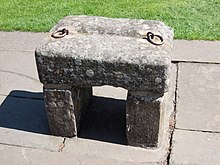 Replica of the Stone of Scone at Scone Palace in Scotland
Replica of the Stone of Scone at Scone Palace in ScotlandThe abbey saw "Prayers For Prisoners" suffragette protests in 1913 and 1914. Protesters attended services and interrupted proceedings by chanting "God Save Mrs. Pankhurst" and praying for suffragette prisoners. In one protest, a woman chained herself to her chair during a sermon by the Archbishop of Canterbury.[55] On 11 June 1914, a bomb planted by suffragettes of the Women's Social and Political Union exploded inside the abbey.[61] No serious injuries were reported,[62] but the bomb blew off a corner of the Coronation Chair.[61] It also caused the Stone of Scone to break in half, although this was not discovered until 1950 when four Scottish nationalists broke into the church to steal the stone and return it to Scotland.[61]
In preparation for bombing raids during World War II, the Coronation Chair and many of the abbey's records were moved out of the city, and the Stone of Scone was buried.[63] In 1941, on the night of 10 May and the early morning of 11 May, the Westminster Abbey precincts and roof were hit by incendiary bombs.[64] Although the Auxiliary Fire Service and the abbey's own fire-watchers were able to stop the fire spreading to the whole of the church, the deanery and three residences of abbey clergy and staff were badly damaged, and the lantern tower above the crossing collapsed, leaving the abbey open to the sky.[65] The cost of the damage was estimated at £135,000.[66] Some damage can still be seen in the RAF Chapel, where a small hole in the wall was created by a bomb that fell outside the chapel.[67] No one was killed, and the abbey continued to hold services throughout the war. When hostilities ceased, evacuated objects were returned to the abbey, 60,000 sandbags were moved out, and a new permanent roof was built over the crossing.[63] Two different designs for a narthex (entrance hall) for the west front were produced by architects Edwin Lutyens and Edward Maufe during World War II, but neither was built.[68][69]
Because of its outstanding universal value, the abbey was designated a UNESCO World Heritage Site in 1987, together with the nearby Palace of Westminster and St. Margaret's Church.[70]
In 1997, the abbey, which was then receiving approximately 1.75 million visitors each year, began charging admission fees to visitors at the door[71] (although a fee for entering the eastern half of the church had existed prior to 1600).[72]
21st centuryIn June 2009, the first major building work in 250 years was proposed.[73] A corona – a crown-like architectural feature – was suggested to be built around the lantern over the central crossing, replacing an existing pyramidal structure dating from the 1950s.[74] This was part of a wider £23-million development of the abbey completed in 2013.[73] On 4 August 2010, the Dean and Chapter announced that, "after a considerable amount of preliminary and exploratory work", efforts toward the construction of a corona would not be continued.[75]
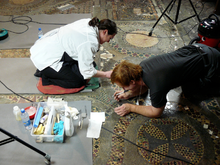 Conservators carrying out restoration work on the Cosmati pavement, 2009
Conservators carrying out restoration work on the Cosmati pavement, 2009The Cosmati pavement underwent a major cleaning and restoration programme for two years, beginning in 2008.[76] On 17 September 2010, Pope Benedict XVI became the first pope to set foot in the abbey when he participated in a service of evening prayer with archbishop of Canterbury Rowan Williams.[77] On 29 April 2011, the abbey hosted the wedding of Prince William and Catherine Middleton.[78]
In 2018, the Queen's Diamond Jubilee Galleries were opened. Located in the medieval triforium, high up around the sanctuary, they are areas for displaying the abbey's treasures. A new Gothic access tower with a lift was designed by the abbey architect and Surveyor of the Fabric, Ptolemy Dean.[79][80]
In 2020, a 13th-century sacristy was uncovered in the grounds of the abbey as part of an archaeological excavation. The sacristy was used by the monks of the abbey to store objects used in Mass, such as vestments and chalices. Also on the site were hundreds of buried bodies, mostly of abbey monks.[81]
On 10 March 2021, a vaccination centre opened in Poets' Corner to administer doses of COVID-19 vaccines.[82]

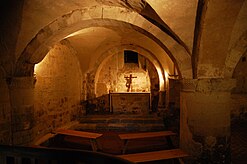






































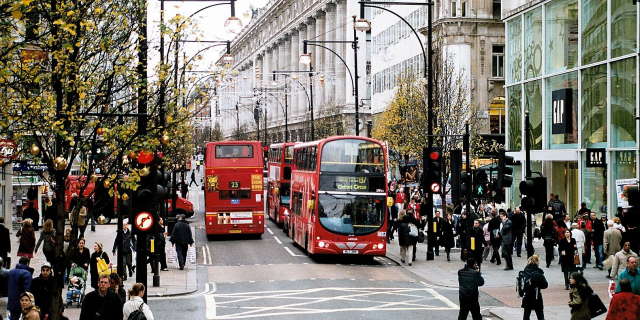






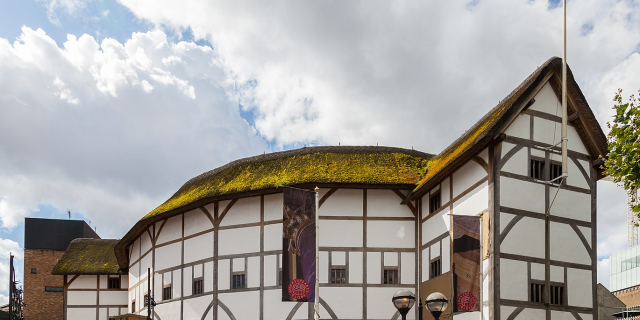
Add new comment